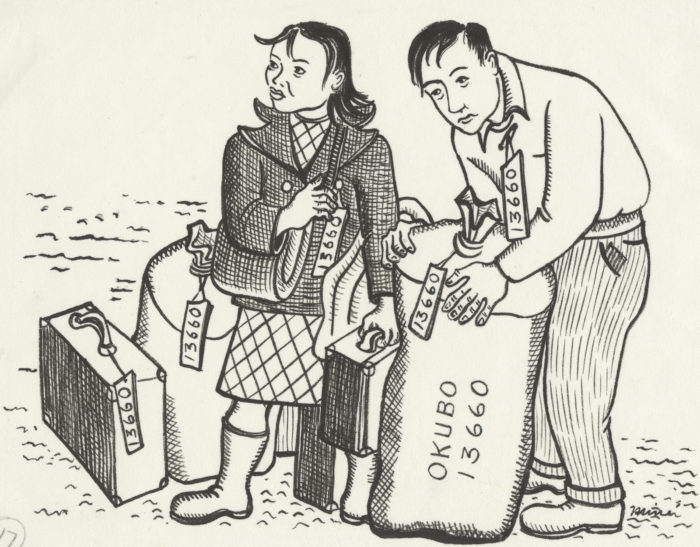Train Ride to the Unknown
Japanese American National Museum, Gift of Eiichi Edward Sakauye (96.147.1)
Click to open full-size image in new tab.Watch this home movie shot by Eiichi Edward Sakauye, who documented inmates arriving at Heart Mountain, Wyoming. Most of the camp’s 10,767 inmates came from California, Washington, and Oregon.
- How did they get to Heart Mountain?
- When they arrived, who was there to greet them?
- How old were the inmates?
- If you were being taken by train to Heart Mountain, what thoughts do you think might be going through your mind?

Miné Okubo, Untitled (Miné and Benji standing with their luggage, Berkeley, California, 1942), 1942, ink on paper, Japanese American National Museum, Gift of the Miné Okubo Estate (2007.62.23)
Click to open full-size image in new tab.Look carefully at this drawing of siblings Miné and Benji Okubo.
- What is the first thing you notice?
- How might you describe the expressions on their faces?
- Their last name, Okubo, is written on one bag. What do you think “13660” is? Why do you think that number is everywhere?
The Okubos are waiting with their luggage to be taken away from their home in California. The government assigned them “13660” as their family number, and they have been instructed to pin that number on themselves and to all of their luggage. They do not know it yet, but they will eventually be incarcerated in Topaz, Utah.

Japanese American National Museum, Gift of Mori Shimada (92.10.2AT)
Click to open full-size image in new tab.Look carefully at this photograph taken by Mori Shimada at Heart Mountain in 1945, when World War II was coming to an end and Japanese Americans were beginning to leave camp.
- Have you ever been on a train with so many other people? What was it like?
- What do you think the weather was like on that day?
Japanese American National Museum, Gift of Eiichi Edward Sakauye (96.147.1)
Click to open full-size image in new tab.This home movie clip was taken by Mr. Sakauye as people were leaving Heart Mountain at the end of World War II.
- How can you tell that people are leaving camp?
- How do you think the people leaving might have felt?
- How do you think the people who remained in camp felt?
Japanese American National Museum, Gift of Eiichi Edward Sakauye (96.147.1)
Click to open full-size image in new tab.The War Relocation Authority removed more than 100,000 people from the West Coast. After considering over 300 sites at which to possibly confine the Japanese Americans, it eventually selected 10 sites that met the following criteria:
- Not near areas deemed strategic by the military
- On public lands
- Transportation and utilities nearby
- Could hold a minimum of 5,000 inmates
- Water, soil, and climate favorable enough to provide year-round opportunities for food production, war production, or public works
- How is this story of forced migration similar and different from other events in US history and peoples’ experiences in other nations?
Return to Migration
